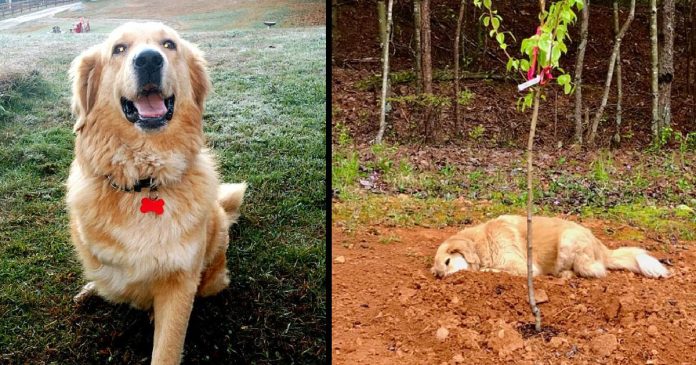Dogs are known for their remarkable emotional intelligence. They have the capacity to form genuine emotional connections, not only with humans but also with other animals. These bonds often become evident, especially in times of loss.
Tricycle’s Unwavering Loyalty
Tricycle, a resilient three-legged golden retriever rescue, calls the Horse Creek Stable Rescue Sanctuary in Mineral Bluff, Georgia, his home. This sanctuary welcomes a variety of special-needs animals, including dogs, llamas, and alpacas.
One of Tricycle’s closest companions at the sanctuary was Major, a St. Bernard/mastiff mix. The year 2016 brought sorrow as Major passed away, leaving Tricycle visibly affected.

Tricycle’s Grief
Major, like other beloved animals at the sanctuary, found his final resting place on the farm grounds, marked by a dedicated headstone. Yet, something extraordinary happened after Major’s burial: Tricycle began a daily pilgrimage to his friend’s grave, a display of his profound grief.
For about three days, Tricycle faithfully visited Major’s resting place, and his caregivers recognized his distress.
Lester Aradi, the sanctuary’s owner, conveyed, “Like many of us, there’s a feeling of loss that we all need to deal through. Animals, like humans, experience loss.”
The Wider Spectrum of Tricycle’s Compassion
What touched the hearts of those at the sanctuary was that Tricycle’s mourning extended beyond Major. He also visited the graves of other departed animal companions, including Trixie, a recently deceased alpaca. This demonstrated that his expressions of grief were not limited to a single bond; rather, they encompassed all the creatures he had grown to love.

**FAQs:
**Q1: Do dogs really grieve like humans?**
A1: Yes, dogs can experience grief and display signs of mourning when they lose a loved one, be it a human or another animal. Tricycle’s story is a testament to this emotional capacity.
**Q2: How do dogs show their grief?**
A2: Dogs may exhibit grief through behaviors like visiting the grave of a departed companion, changes in eating habits, lethargy, and vocalizations. Tricycle’s visits to his friends’ graves are a clear example of such mourning behavior.
**Q3: Can dogs form bonds with animals of different species?**
A3: Yes, dogs can form strong emotional bonds with animals of different species. Tricycle’s relationships with dogs, llamas, alpacas, and others at the sanctuary illustrate this ability to connect across species boundaries.
**Q4: Is Tricycle’s story unique, or do other dogs display similar behaviors?**
A4: While Tricycle’s story is touching, it’s not entirely unique. Many dogs have been observed grieving the loss of their animal companions or even their human family members, underscoring the depth of their emotions and capacity for attachment.
**Q5: How can we support a grieving dog?**
A5: Providing comfort, maintaining routine, and offering extra attention and affection can help a grieving dog. Additionally, consulting with a veterinarian or animal behaviorist may be advisable if the grief persists or leads to concerning behavior changes.

